![]() 1st Battalion 22nd Infantry
1st Battalion 22nd Infantry ![]()
November
1969
First Day in-Country
First Day in the Field
and
First Combat Assault
By James Henderson B/1-22, 2nd Platoon
My first day in Vietnam was Nov
22, 1969. I landed at Bien Hoa (Ben Wah) Air Base aboard a
commercial airliner. I believe it was a DC8
of either United or Flying Tigers Airline. The U. S. Government,
or I guess maybe the U. S. Army, contracted with civilian,
private airline
carriers to shuttle troops to and from Southeast Asia. The plane
was filled with nothing but soldiers. We had stewardesses and I
believe
they served us soft drinks (no alcohol! Ha!) and some form of a
meal. Vietnam is 14 hours different from Oakland, where we had
left from,
plus you cross an International Dateline. I originally had a seat
mate who was determined that he was going to keep his watch on
Oakland time
and not change it a dozen times as everyone else was doing. I
lost track of him, so I don’t know if he kept his vow or
not. We had a brief stop
in Hawaii, maybe an hour, and then we left Hawaii and got about
an hour out over the open Pacific Ocean and the pilot announced
we were
having mechanical problems and that we were turning back to
Hawaii. Not exactly the type thing you want to hear while in the
middle of the
Pacific Ocean. In any event, we got back to Hawaii, and they had
trouble fixing whatever was wrong and wound up letting us wander
and roam
the airport for 4-5 hours. Eventually, they gather us all back up
via the public address system and inform us that if they
can’t fix the plane or
find us another plane in the next hour then they’re going to
put us up in a hotel. Never have so many GI’s prayed so
hard, but it was not to be,
they found us another plane and we continued on our journey.
After Hawaii, our next stop was Guam and then the Philippines and
then on to
Vietnam. From the time we originally left Oakland until we landed
in Vietnam, it was a 24-hour journey.
Once we landed at Bien Hoa, in
Vietnam, there were buses waiting for us on the tarmac. I recall
that the buses had no windows or perhaps
they were simply open because of the heat, and they had wire mesh
over the windows, I was not sure if it was to keep us from
escaping or to
prevent someone from tossing a grenade inside. Again, not exactly
comforting. We journeyed out into the civilian roadway for a
short drive
down the road to Long Binh (Long Bin), a very large Army base and
home to the 90th Replacement Battalion Depot. This was referred
to
as the 90th Repo Depo (pronounced Rep-o Dep-o).
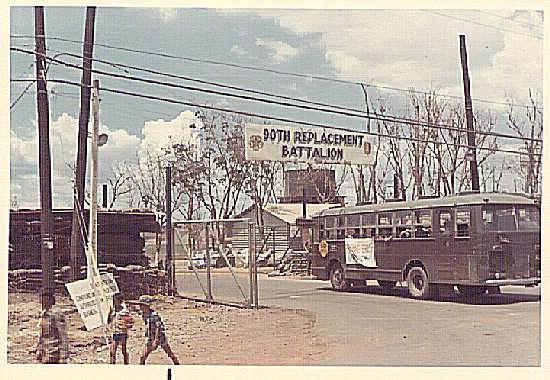
90th Replacement Battalion at Long Binh
Photo from the A Trooper Reports webpage
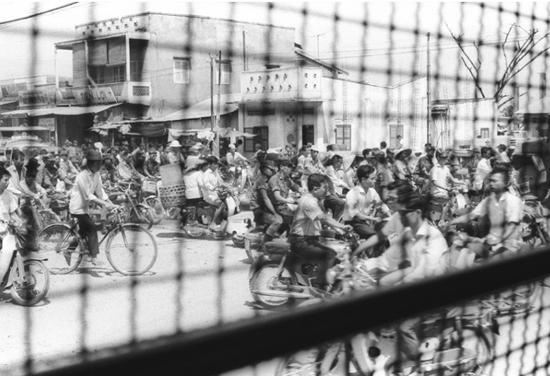
View looking out the
wire mesh ciovered window of a bus going from
the airfield at Bien Hoa to the 90th Repo Depo at Long Binh
Photo from the A Trooper Reports webpage
|
Not all of
my tour, but most of it, Binh Dinh
Province was Map of Republic of
“South” Vietnam from |
I only stayed one night I think,
possibly two, at the Repo Depo. This is when and where I was
assigned to the 4th Infantry Division.
An Infantry Division in Vietnam was composed of approximately
16,000 men.
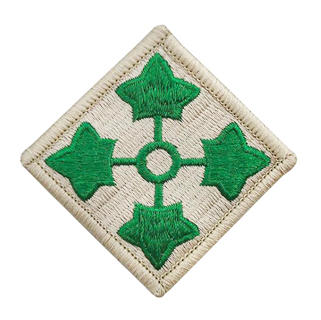
4th Infantry Division shoulder patch
I never see any of my plane, bus,
nor Repo Depo mates again, we all part company, going to
different locals. The 4th Infantry Division
was now my parent unit. A civilian might view this as the first
step in my address, such as saying I was assigned to Texas. From
this point
in time, I traveled to Pleiku (Play-coo) and its Army base, Camp
Enari ( Ah-nar-ee) which at that time, was the base camp for the
4th Infantry
Division. Camp Enari was named after 1st Lieutenant Mark Enari,
the first 4th Division soldier awarded a Silver Star
(posthumously) in Vietnam.
He was killed in action on Dec 2, 1966. I do not remember if we
flew or were trucked from the 90th Repo Depo to Camp Enari but I
think
trucked, even though it’s pretty far. The Army relied
heavily on 2 ½ Ton trucks, referred to as deuce and a
half’s, to transport troops that
weren’t being choppered, flown by helicopter. Each truck
could hold approximately 20-25 soldiers.
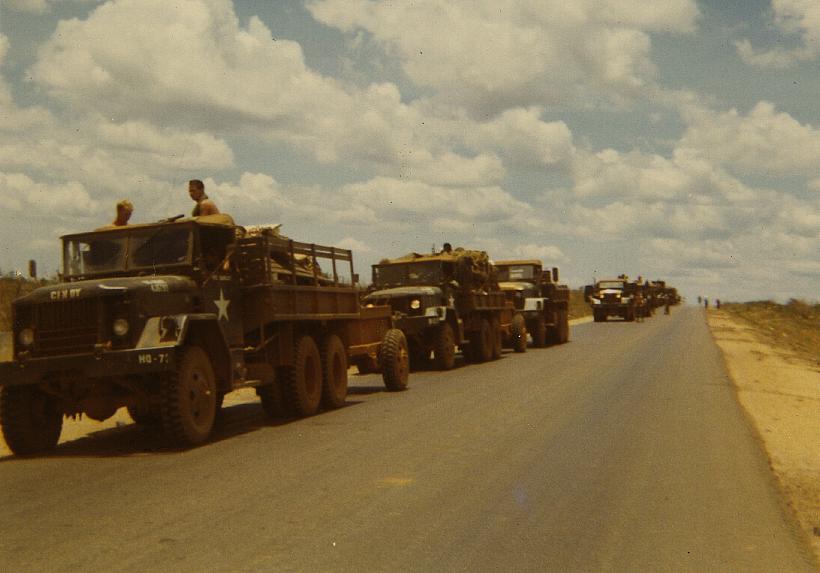
U.S. Army 2 ½ ton trucks outside of Camp Enari, waiting to load troops
Photo courtesy of David Parrish
Once at Camp Enari we were issued
our weapon, an M16, and various other equipment such as our ruck
sack and air mattress, poncho
and poncho liner, canteens and so forth. The base commanders also
utilized the FNG’s (F……ing New Guys), us, every
night to pull
night guard duty on the perimeter of the Army base. The Sergeants
who were actually in charge of the guard duty, harassed us
FNG’s
with a story that Ho Chi Minh, known to one and all as Uncle Ho,
the revered and much beloved communist leader of North Vietnam,
who had died a couple of months before, September 2, to be
specific, had left a last request to be buried in Pleiku which
they claimed
was his ancestral birth home (not true it turns out). The
Sergeants further stated that they, the NVA (North Vietnamese
Army), were expected
to do this on or before Thanksgiving Day, which was November 27,
1969. I was on perimeter guard the 26th, 27th, and 28th. At the
time,
this seemed very frightening and scary. Incredibly scary, and
I’m sure none of us slept a wink those few nights. The
result they sought,
I’m also sure.
On another occasion we, the
FNG’s, were in some sort of classroom orientation, I forget
what it was exactly, there were maybe 30 guys
in the classroom and someone bursts through the door and all
breathlessly shouts that we’re under ground attack and that
we need to get
to the bunker line. In a mass panic never seen before nor since,
we jump up and bolt blindly for the door, stepping over and on
top of
one another, in a stampede remindful of a herd of Longhorns in an
old Western movie. Overturning chairs and desks, total and
complete
pandemonium! Chaos! It’s a wonder someone wasn’t
seriously hurt. I don’t recall if they were trying to make a
point about keeping one’s
wits about themselves in time of perceived danger or if they were
just messing with us. Later and in hindsight these days would
seem
like a vacation. Ha!
When we weren’t in an
orientation classroom or pulling guard duty, we were housed in
the Transient Barracks. Not only the FNG’s
stayed here but also guys coming and going on R&R (Rest and
Rercuperation). I had the good fortune of being befriended by a
seasoned
old salt, we called them short timers due to the fact that they
only had a short time left in Vietnam. James Cannon took me under
his wing
enough to show me what I needed to jettison and what I needed to
keep as to the equipment that I had been issued, a mosquito net
for example.
“You won’t need this where you’re going” he
said. (WHERE I’M GOING !!!??? my brain probably screamed) He
also showed me the best way
to pack my ruck sack the most efficiently. I figured, and
I’m sure he did too, that we’d never see one another
again, but lo and behold
I wound up in the same company that he was in. He was an RTO
(Radio Telephone Operator) in the Company CP (Command Post)
and while we rarely actually saw one another, we did cross paths
occasionally.
We stayed here in Pleiku, at Camp
Enari, for 3-4 days and it was here that I was assigned to the
1-22 Infantry Battalion. An Infantry Battalion
in Vietnam was comprised of approximately 600-800 men. There were
12 Infantry Battalions in the 4th Infantry Division.
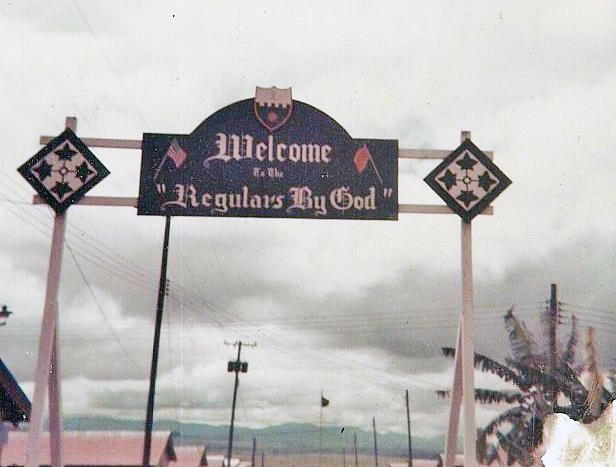
Sign at the 1st
Battalion 22nd Infantry area at Camp Enari, Pleiku
Note 4th Division emblems on each end of sign and 1-22 Unit Crest
at top center
Photo courtesy of Doug Childs
So, now I've been assigned to the
4th Infantry Division's 1st Battalion 22 Infantry. All I need now
is to be assigned to a specific Company
within the Battalion. A Company is roughly 120 men. There are 5
Platoons within the Company. A platoon contained 25, perhaps 30,
men.
When I'm finally assigned to my platoon, these will be the men
that I spend my tour with. Some will go home, and new ones will
come in,
but this will be the core group that I am with 24/7.
On the 29th, we traveled via
convoy from Camp Enari to LZ English (Landing Zone English),
which at that time was the base camp for
the 173rd Airborne and the 1st Cavalry Division. The roadways,
while paved, were often exceedingly narrow. If the truck drivers
were not
careful, which they were not, they would get so close to one
another passing in the opposite direction, that they would slap
mirrors. It was not
wise to let one’s hands nor arms dangle over the side of the
truck. This convoy wound through the rural countryside, and it
was truly beautiful
country indeed. If a person likes lush greenery, which I do, then
you couldn’t help but appreciate its beauty. Rice paddies
dotted this green
landscape. In the places where the peasants had carved out farms,
small, very small, communities had popped up. Small villages I
guess you
could say. The houses (huts?) crowded right up to the road
itself. Such a collection of huts, I had never seen! Mostly
constructed from
cardboard, yes, I said cardboard, they were a sight to behold.
Our C-ration meals came boxed 12 meals to a case. The case itself
was a very
thick and heavily waxed box maybe 18”x24”. If broken
down and folded back against itself, it was quite strong and
waterproof to boot.
This is what they used for siding. No brick nor shiplap here!
Cardboard houses! The entire area would be a beehive of activity.
Bicycles,
mopeds, ox carts, mama sans utilizing balance poles to carry
ridiculously heavy loads, everyone scurrying about in a seemingly
big hurry
to get somewhere. Their short, rapid, choppy steps, 3 or 4 to our
two, made them seem even more like they were really covering some
ground.
And the kids! Kids everywhere! Crowding the roadway in a most
unsafe manner, all with their hand out begging. Chanting “GI
number one”,
meaning we were the best. Ha! Yeah. If the convoy bunched up and
our particular deuce and a half came to a complete stop, the kids
would
appear from nowhere, dozens of them. And, if someone actually
gave them something - - candy bar, cigarettes, anything - - -
their numbers
would swell even more. And, if we were stopped for any length of
time, say 10 minutes, the teenage “coke girls” would
appear trying to sell us
canned cokes. Which in itself begs the question as to where did
they get the cokes to begin with? Black market? It was quite an
adventure
and we eventually arrived safely at LZ English.
Vietnamese mother carrying
her two children |
|
I’ve been in-country for a
week now. LZ English was much smaller and seemed more vulnerable
than Camp Enari and I thought, man
I’m really in the boonies now. Scary!
The next day, on Nov 30th, I was
taken to the chopper pad at LZ English and got on a chopper for a
ride to LZ Beaver (Landing Zone),
which was the home of the 1-22 Battalion. It was my first chopper
ride and LZ Beaver, being “only” a Battalion size fire
base, was surely the
smallest and most vulnerable location a person could imagine. A
Battalion fire base, often times but not always, was referred to
as an LZ but
sometimes as Fire Support Base something or other, it could be
either way. It was about an acre in size and utilized an infantry
company,
100-120 men, manning sandbag reinforced bunkers around the
perimeter. Generally, it was on a mountain top, but not always.
It was usually
more or less roundish or a rough rectangular shape, but that
depended on the terrain on top of the mountain top. Maybe 20-25
bunkers in all
with 4-5 men per bunker. It would have an Artillery Battery,
three to six 105mm Howitzer cannons and an assortment of smaller
organics
such as 81mm mortars and 4.2” mortars. The Battalion
Headquarters would be in the center composed of 6-8 bunkers. It
would have a
landing pad for choppers but nothing big enough for an airplane.
Perhaps 150-200 men..…………NOW I’m in the
boonies. Seriously scary!
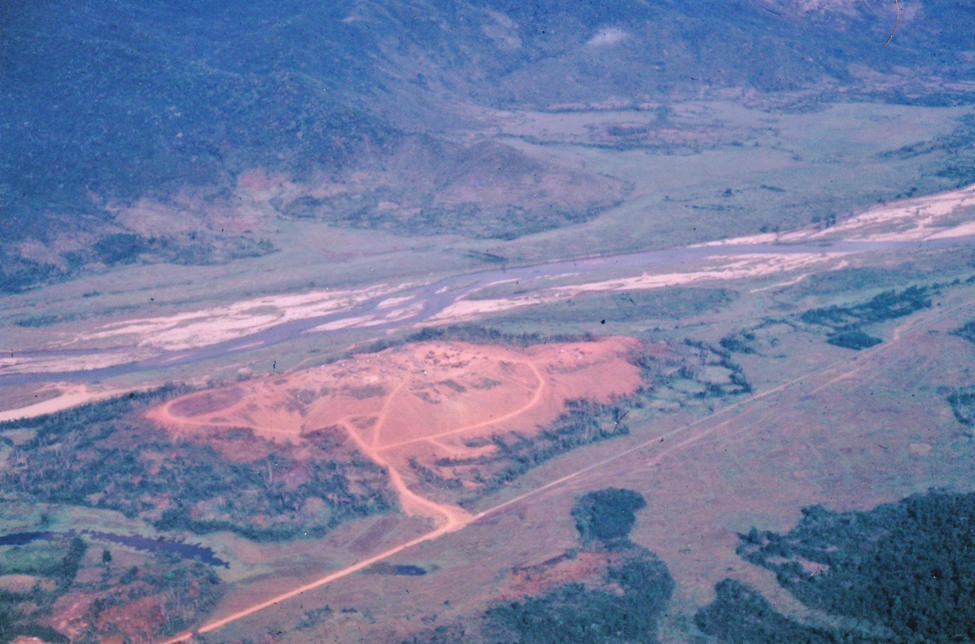
LZ Beaver, situated
along the An Lao River in the An Lao Valley of Binh Dinh
Province. Personally, I never felt comfortable being on such low
ground
with mountains all around me. But we never had any trouble there
that I know of.
Photo courtesy of Harry Beck
I spent three or four nights on LZ
Beaver thinking (hoping?) that this was the end of the road and
things couldn’t get any worse than this.
Little did I know.
On the morning of Dec 4th, still
at LZ Beaver, I was informed that I was to be assigned to B
Company, 1-22 Infantry. I was further informed
that B Company was “in the field” and I was instructed
to report to the chopper pad and catch a ride out to B Company.
Hmmmm, I thought
that I WAS “in the field”. There were a couple of
seasoned veterans at the chopper pad waiting for a lift out to B
Company and they took me
under their wing. I was the only FNG on board. There were maybe
3-4 other guys and various supplies. The chopper landed at LZ
Beaver
and we piled on, sitting in the open doorway with our feet
dangling out, headed out to the “field”. I was
petrified.
The chopper climbs to altitude
with me sitting in the open doorway, looking out at a sea of
impenetrable triple canopy jungle and steep mountains
of the An Lao (Awn-Low) valley in Binh Dinh Province (Ben Den),
Republic of South Vietnam. Eventually a mountain top with a small
clearing
carved out of the jungle appears and we begin to descend towards
it. It becomes clear to me that this is our final destination,
the chopper pilot
comes in hard and fast and doesn’t touch down, instead
hovering perhaps 2 feet off the ground. Following everyone
else’s lead, I jump from the
“safety” of the chopper doorway onto the ground below.
Truly, truly from the frying pan into the fire. I was so scared
that it’s a wonder my legs
could even move. I literally went ass over tea kettle, the weight
of the overloaded ruck sack burying me face first into the jungle
floor. My helmet
went flying halfway across the clearing. I frantically clawed my
way erect and scrambled towards the trees and hopefully the
safety of the wood
line, collecting my helmet as I went, thinking any minute a
thousand gooks would open up firing on me! My heart was pounding
so violently
that I feared everyone within the valley could hear it. As I
reached the wood line, there were two grizzled old short timers
sitting there in the shade
manning a PRC 25 radio (Portable Radio Communications 25, I do
not know what the 25 stood for). These were FM band radios of
reasonably
long range, each platoon usually had two and they would usually
communicate with the nearest LZ, such as LZ Beaver or by changing
frequency
could be made to communicate with the chopper pilots. I do not
remember their exact words but something to the effect: “Sit
down kid, relax,
take a load off, take that heavy looking ruck sack off. The CO
(Commanding Officer) of B Company, has assigned you to 2nd
Platoon.” At that
point in time CPT John D’Errico was the CO of B Company. My
final destination and my new home, 2nd Platoon, B Co, 1-22
Infantry,
4th Inf Div. I had survived my first CA (Combat Assault), the
first of what was to be 25+ CA’s and an Air Medal. A Combat
Assault to a grunt
was any chopper ride into an unsecured LZ. If we completed 25 or
more of these CA’s we were awarded an Air Medal. For actual
airmen,
such as pilots, the criteria for being awarded an Air Medal was
much different. And now, NOW, NOW I was in the boonies!
I’m not sure what the moral
of the story is nor what the lesson learned. My oldest daughter
so loved the story, after I recited it one day
swinging in the glider on my patio, that she insisted that I
write it down. She sees all sorts of life lessons in it that she
wants to impart to her sons.
For me, I guess I’d say that no matter how bleak the
situation appears, it can always get worse. And no matter how
“worse” it gets, it can also be
salvageable and survivable. Pessimism and optimism all rolled
into one! I hope and pray that I am ever the
optimist………………. even when
things do seem bleak. And, somewhere rolled into the lessons
learned is the John F. Kennedy quote from a few years earlier,
and before him
FDR, “…the only thing we have to fear, is fear itself
“. That lesson has been learned by me over and over
throughout life. It seems that I can
never quite grasp it and retain it. I would also say that an
interesting insight to the entire episode is the value of
hindsight, in that what at the time
seemed terrifying turns downright humorous in hindsight. Not
always, but often. Sometimes? :)
So, November has ended, and December has begun. Let's now fully explore the month of December 1969.
Home | Photos | Battles & History | Current |
Rosters & Reports | Medal of Honor | Killed
in Action |
Personnel Locator | Commanders | Station
List | Campaigns |
Honors | Insignia & Memorabilia | 4-42
Artillery | Taps |
What's New | Editorial | Links |